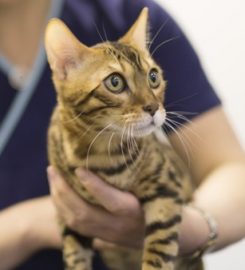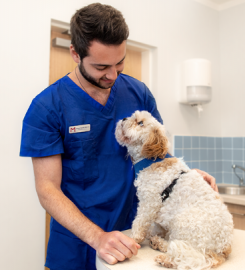Medivet Bracknell Harmans Water – Kynoch Vets
Pet Vaccinations
Vaccinations are an essential part of responsible pet care, but many owners aren’t fully aware of the benefits of vaccinating their pet or the risks of not doing so. A vaccination appointment provides a chance for your vet to conduct a full nose-to-tail check of your pet to ensure they’re fit and healthy. If there are no signs of illness or injury, they’ll review your pet’s vaccination history and discuss their needs with you before giving them the necessary vaccines.
What is pet microchipping?
A pet microchip is a tiny computer chip about the size of a grain of rice. It contains a unique code, used as a permanent form of ID and security for your pet.
Once your pet’s been microchipped, you’ll receive confirmation from a registered database containing an ID or reference number, plus your pet’s microchip number.
If your pet goes missing and is later found, it simply needs to be scanned by a device a vet or animal shelter will have. This will recognise the microchip’s unique code and identify your pet.
How to update your pet’s microchip details
If you move house or change your phone number, you’ll need to contact the database where your pet is registered to change your contact details. If you know the database your pet is registered with, you can simply check your details are up to date by contacting the database team over the phone.
If you don’t know the database your pet is microchipped with, take them to your local vet or rescue centre. They’ll be able to do a scan and give you the number.
Ultrasound
A pet ultrasound is a non-invasive imaging technique used to view your pet’s internal organs and identify potential issues.
What’s a pet ultrasound?
An ultrasound is a safe, non-invasive diagnostic procedure that gives your vet a two-dimensional ‘picture’ of your pet’s organs. In the procedure, a hand-held probe uses sound waves to create an image that’s displayed on a monitor.
When do we do a pet ultrasound?
It can be used to investigate issues such as:
- A heart murmur
- Irregular heartbeats (arrhythmia)
- Laboured breathing
- Birth problems
- Organ diseases (e.g. liver and kidney problems)
- Vomiting and diarrhoea
- Foreign objects in the body
- Tendon injuries
- Pregnancy
- Urinary problems
- And many others
What does a pet ultrasound involve?
It’s sometimes not necessary to anaesthetise or sedate your pet for ultrasound examinations as the technique is completely painless. Many pets will simply lie comfortably while the scan is being performed. If your pet is particularly sensitive or anxious, a sedative may be needed.
Your pet’s hair will generally need to be clipped over the area being examined to allow for a clear image. Your vet will then place gel on the area and methodically move the ultrasound probe around to record images of the area of interest.
Ultrasound is perfectly safe, and unlike an x-ray doesn’t expose your pet to any radiation.
If you have any questions about pet ultrasounds, contact your local practice who will be happy to help.
About Us
We’re a community of passionate veterinary professionals, dedicated to delivering exceptional care that’s always there. The top priority of our partnership of experienced and caring vet surgeons is your pet’s well being. In fact, our mission is to deliver progressive, around the clock care, whenever your pet needs it.





